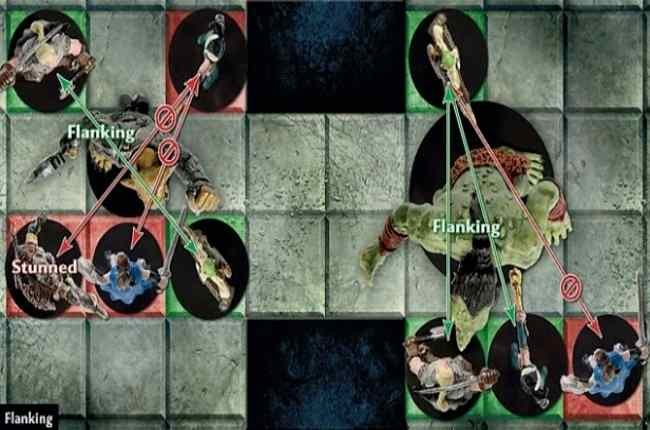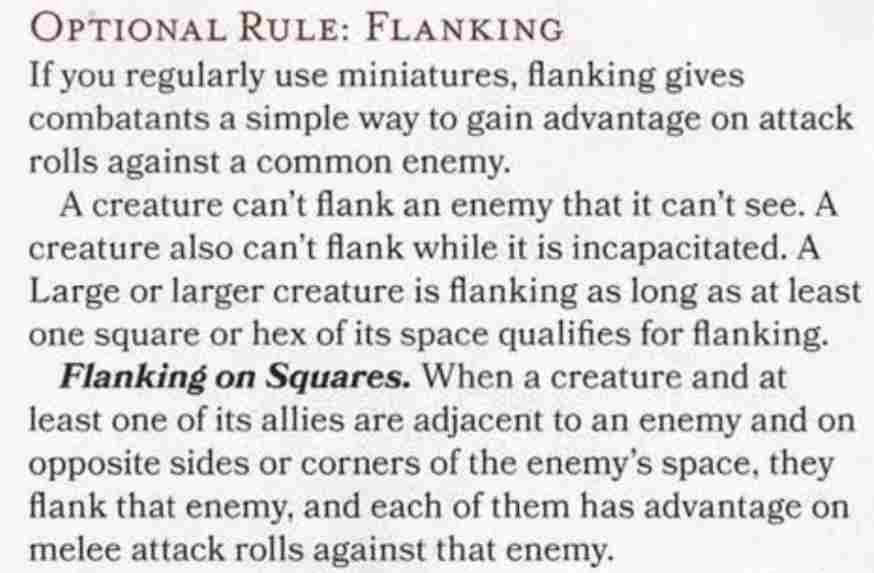The Rules of Flanking 5e – DnD Complete Guide 2021

What is the condition for using Flanking 5e in DND? How to use Flanking on Squares and on Hexes? What if a third creature is present?
DND is a fantasy game in which players assume fictional characters that belong to various races. The fifth edition of Dungeons and Dragons has been released recently and they contain many races that are new additions. It is popular across the world and there are avid players who love this role-playing game. 5e races are exotic and each of them has unique characteristics.
The role-playing game is versatile and improves with each latest version. Also, DND 5e has a new rule called flanking. Flanking 5e rule allows a creature to have an advantage on attack its enemy when another one of its allies is present on the other side of the common enemy. There are some conditions when this can happen and let us see in detail about it here.
More about Dungeons and Dragons!
Dungeons and Dragons allow its players to assume characters that belong to a fantasy world. The game is accomplished by a book that has all the rules explained in it. The various races, their characteristics, and history are all discussed in this book. The game has players who assume different races and a dungeon master who is not a character player. The dungeon master is the decision-maker and the players have to obey it.
There are many different races that the players can assume and they can have the abilities of that race. They can cast spells and carry weapons. There are many versions available and many game settings available.
What is the condition for using Flanking in DND 5e?
Flanking 5e can be done only under specific conditions and players have to obey it. There has to be a creature and at least one of its allies near an enemy. The enemy has to be positioned in the center. Both the allies have to be on the opposite sides and in a straight line. That is all the three has to stand in a straight line. The creature has to be behind the enemy. Only then this tactical advantage can be used.
Apart from this, the creature should see the enemy and this visibility should be there. And another thing to note is that creature that is incapacitated cannot use flanking. Only then flanking can be taken advantage of. Also, the rules clearly state that this rule can be used only when miniatures are used. When dungeons and dragons game is played with miniatures, flanking rule can be used.
What do DND players think of Flanking 5e rule?
Flanking 5e is disliked by many dungeon masters and many players tend to forget it in course of time. Most of them do not see the benefit of the advantage on attack role. The optical rule is considered by many as a silly one. Many players also consider this advantage on the attack against an enemy a wrong thing to do and opposed using this. There are many controversies surrounding this powerful rule and let us see why this rule is opposed so much.
Two Kinds of Flanking 5e!
There are two kinds of flanking which can be done. One is flanking on squares and the other is flanking on hexes. Both of them make use of the flanking rule with slight variations. Knowing how to use this rule when you are using grid and hex can be beneficial.

How to use Flanking on Squares?
Flanking on the square requires the creature and the ally to be placed adjacent and on opposite sides of the enemy. Not only opposite sides but even opposite corners are allowed while flanking. The creature and the adjacent ally can each take advantage of melee attack rolls and the enemy will get flanked. A great way to ensure the usage of flanking is to draw an imaginary line. Drawing or teaching an imaginary line that connects the creature and its ally with the enemy in central should be straight. Only then, flanking is allowed.
How to use Flanking on Hexes?
Flanking on hexes also requires the creature and the ally to be near each other and on the opposite sides to the enemy. Here the number of hexes should be counted to determine if flanking is possible. Flanking 5e can be felt difficult since players have to count the hexes and then remember them.
But as time goes, it will become easy. The hexes can be counted by starting from the creature to its ally and around the common enemy. Usually, the side with a greater number of hexes is taken for counting since it has more advantages. When there is a small creature, then the number of hexes between the creature and ally should be two. This also applies in the case of medium creatures.
However, if the enemy is large, then the number of hexes must be four. Only then flanking the enemy is possible. Against a huge enemy, the number of hexes in between a creature and ally should be five. Also, if the enemy is a Gargantuan, then the number of hexes should be six.
What if a third creature is present during Flanking 5e?
Usually, melee attacks only benefit from using the flanking 5e rule. Even spells can be used while doing melee attacks in flanking. Consider there is a third creature near the enemy which is an ally to the other two creatures. But the third creature will not consider flanking and it cannot take part in flanking.
This is because it is not the opposite of any of the other allies. But imagine a scenario where the enemy is a large creature. If a creature is present behind it and two other creatures are present opposite on the other side, they can flank. In case you are playing using a hex map, then the third ally should be counted from the other direction.
This is because the third ally can be present near the second ally and there might be zero hexes between them. That is why we count from the other direction to get as many hexes in between as possible.
Execution matters while Flanking!
Most of the time flanking is a more threatening strategy if not executed well. Due to a specific place for roleplay tokens, just to overcome the enemy, they make themselves afar from the enemy boundary. Just for your own assumption, since your rivals are also flanking on you and you make yourself too distant from the enemy, then flanking is fine it’s quite technical.
You have to make sure that always be in connection with your partner. Sometimes even the rulebook is indefinite about unseen creatures and the flanking. Your ally can be hiding behind the enemy line and be completely unseen. Automatically the enemy doesn’t bother about anything tactically. In that scenario you have to talk immediately with your DM, start discussing the invisible creature and how to tackle them.
Pivotal Role of the Battle master!
On to the core, the creature needs to be an ally or anything in that part is enough to qualify for flanking. One main advantage is the creature beyond the enemy borders has the tendency to be expendable. Allowing them to fight back is a greater benefit. Otherwise, you can surround them with requests, they can share each of their power and burst out big damage.
It is unnecessary to push your original party into a threat with some crowd regions. The battle master has a pivotal role to pull and push, so the rivals can migrate into a better position. It’s mandatory that there are two or more members in the front line. Then only you have the knowledge of tackling your rivals.
Ranged spells do not gain from flanking 5e!
Melee attacks can benefit a lot from flanking and even spells can be used. For example, using flanking can benefit attacks like vampiric touch and you can benefit from rolling it twice. But there is a limitation in the case of using spells since ranged spells cannot benefit from flanking effectively. Also, ranged weapons do not gain any advantage from this flanking rule. Flanking 5e is completely optional and the players can decide on that along with their dungeon masters.
Downsides to Flanking!
Taking advantage of the others is a tough one for the creatures to grab it. There are few outcomes that are positive when we utilize them. You will have the upper hand only when you start attacking rather than playing the defensive or hiding game. Also these results are a temporary one and might end up in major downfall. So prior planning is essential.
When compared with this kind of tactic, flanking is much more effective than a ruthless or direct attack. Like all other techniques, flanking also having its own setbacks such as hiding or positioning yourself too far from your allies and wrongly positioning yourself in the place that your enemy wants to occupy. The high-risk factor of flanking is getting flanked ourselves.
Powerful rule!
As a DM you have extreme powers like flanking and vice versa you are the sole responsible one to answer all the consequences. As there are many interesting scenarios about the climax role of combat which might be a shocking one.
Also, DM is provided with extreme boosters to attack the rivals. When it comes to the usage of flanking technique, it’s better to go on with our own ideas. The creatures which surrendered themselves are excluded from the count. The advantage of the FACING technique and a lone animal behind the flank creature is also present in the DND game.
The flanking 5e rules have their own pros and cons, but on a whole, it is a powerful tool to overcome the enemy. It’s advisable to use precautionary measures.
Controversies are due to Congo Line!
Flanking is very controversial since many think it is an unwanted rule and others think it is powerful. The main reason that players think that flanking 5e is not great is the Congo line. Congo line is nothing but a scenario where two creatures who are allies flank a monster.
Flanking requires the monster to stand exactly in the center in a straight line to the creatures. When this happens, automatically an ally of the monster can come and stand behind one of the creatures. Thus now the creature will be in between two monsters.
The monsters will be allies and hence they will start flanking the creature. Soon, another creature will come to flank the monster. Thus this process can go indefinitely. This is the reason why so many players hate the flanking rule.
Congo line can be avoided!
This Congo line scenario is completely avoidable and is not inevitable. Simply, the player characters can stop taking part in the Congo line and avoid the situation completely. Most of the time, the monsters will not be considering flanking as they are not as intelligent as other creatures.
Also, sometimes positioning themselves in a dangerous state is not desirable. Hence monsters will try to avoid taking part in flanking through the Congo line. Player characters should also be careful before positioning themselves in the Congo line. What if there are hidden monsters who can support the monster under attack?
Or if there is a spellcaster hiding from you? Thus Congo lines can be avoided largely during flanking. Flanking 5e can be beneficial to certain 5e races like paladins and clerics. While paladins can take advantage out of flanking on smites, clerics can benefit from harmful spells.
A Final word on Flanking Rule!
Flanking 5e is a great rule if used strategically. However, it is completely optional and it is up to your decision to make use of it. Dungeons and Dragons is a game popular among almost all people who like role-playing games. The game takes people on adventures to fantasy lands that they have always yearned for. Many consider that flanking can ruin the fun in the game of Dungeons and Dragons. This is because it is an easy way to take advantage of attack rolls and can be easily obtained.

